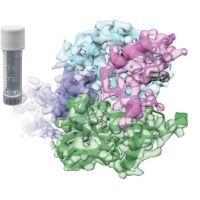Specification
| Organism | Homo sapiens (Human) |
| Expression Host | E.coli |
| Protein Tag | N-terminal 10xHis-tagged |
| Purity | Greater than 90% as determined by SDS-PAGE. |
| Endotoxin Level | Not test. |
| Biological Activity | |
| Uniprot ID | P78356 |
| Gene Names | PIP4K2B |
| Alternative Names | (1-phosphatidylinositol 5-phosphate 4-kinase 2-beta)(Diphosphoinositide kinase 2-beta)(Phosphatidylinositol 5-phosphate 4-kinase type II beta)(PI(5)P 4-kinase type II beta)(PIP4KII-beta)(PtdIns(5)P-4-kinase isoform 2-beta) |
| Expression Region | 2-416aa |
| Product Form | Liquid or Lyophilized powder |
| Buffer | The default storage buffer is Tris/PBS-based buffer, 5%-50% glycerol if the delivery form is liquid. The lyophilization buffer is Tris/PBS-based buffer, 6% Trehalose, pH 8.56 if the delivery form is lyophilized powder. Please contact us if you have any special requirment. |
| Reconstitution | Please reconstitute protein in deionized sterile water and we recommend that briefly centrifuge thevial prior to opening the vial .We recommend aliquot for long-term storage at -20℃/-148℃. |
| Protein Length | Full Length of Mature Protein |
| Molecular Weight | 53.3 kDa |
| Protein Sequence | SSNCTSTTAVAVAPLSASKTKTKKKHFVCQKVKLFRASEPILSVLMWGVNHTINELSNVPVPVMLMPDDFKAYSKIKVDNHLFNKENLPSRFKFKEYCPMVFRNLRERFGIDDQDYQNSVTRSAPINSDSQGRCGTRFLTTYDRRFVIKTVSSEDVAEMHNILKKYHQFIVECHGNTLLPQFLGMYRLTVDGVETYMVVTRNVFSHRLTVHRKYDLKGSTVAREASDKEKAKDLPTFKDNDFLNEGQKLHVGEESKKNFLEKLKRDVEFLAQLKIMDYSLLVGIHDVDRAEQEEMEVEERAEDEECENDGVGGNLLCSYGTPPDSPGNLLSFPRFFGPGEFDPSVDVYAMKSHESSPKKEVYFMAIIDILTPYDTKKKAAHAAKTVKHGAGAEISTVNPEQYSKRFNEFMSNILT |
Background
| Research Areas | Signal Transduction |
| Relevance | Participates in the biosynthesis of phosphatidylinositol 4,5-bisphosphate . Preferentially utilizes GTP, rather than ATP, for PI(5)P phosphorylation and its activity reflects changes in direct proportion to the physiological GTP concentration . Its GTP-sensing activity is critical for metabolic adaptation . PIP4Ks negatively regulate insulin signaling through a catalytic-independent mechanism. They interact with PIP5Ks and suppress PIP5K-mediated PtdIns(4,5)P2 synthesis and insulin-dependent conversion to PtdIns(3,4,5)P3 . |
| Function | |
| Reference | "The Lipid Kinase PI5P4Kbeta Is an Intracellular GTP Sensor for Metabolism and Tumorigenesis." Sumita K., Lo Y.H., Takeuchi K., Senda M., Kofuji S., Ikeda Y., Terakawa J., Sasaki M., Yoshino H., Majd N., Zheng Y., Kahoud E.R., Yokota T., Emerling B.M., Asara J.M., Ishida T., Locasale J.W., Daikoku T. Sasaki A.T. Mol. Cell 61:187-198(2016) |
QC Data
| Note | Please contact us for QC Data |
| Product Image (Reference Only) |  |

